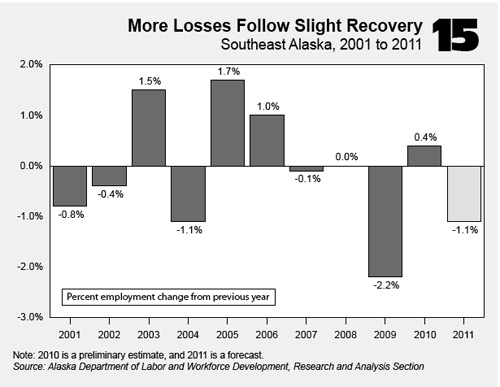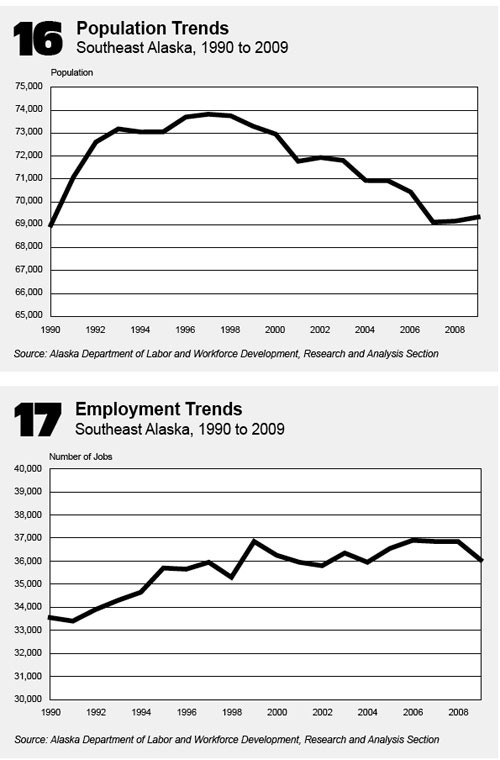
January 11, 2011
“While Alaska felt the effects of the national recession, we fared much better than most states,” Commissioner Click Bishop said in the magazine. Employment levels recovered in 2010 and for the second year in state history, Alaska’s unemployment rate was lower than the nation’s. At this time last year, the department of labor reported a 2009 loss of 2,100 jobs statewide and predicted a loss of 1,400 jobs in 2010. Instead, statewide Alaska added 1,900 jobs between 2009 and 2010. The “Trends” forecast for 2011 is similar to the 2010 estimate: modest growth of about 1,800 jobs. Most industries are likely to remain stable in 2011, with health care providing the largest number of new jobs. The department projects that continued strong commodity prices, a recovering visitor industry, improved consumer confidence, healthy fish harvests, and a strong fiscal position bode well for employment growth in Alaska this year. Unlike the other areas, Southeast may face a slight decline in jobs. Economists expect structural demographic changes and hesitant tourists to erode employment in retail trade, transportation, and leisure and hospitality According to the January 2011 "Trends" article by Mali Abrahamson, Economist with the Alaska Department of Labor, Southeast Alaska exceeded economic expectations in 2010. Even though economic forecasts predicted a loss of jobs, Southeast’s preliminary counts show a 0.4 percent net increase in nonfarm employment said Abrahamson. Though the overall change in Southeast Alaska was small, there was movement in many sectors said Abrahamson in the January issue of Alaska Trends. Trade, transportation, manufacturing, information, construction, and leisure and hospitality lost jobs last year, while education, health care, professional and business services, and mining industries employment grew. Abrahamson predicted that despite mild job recovery in Southeast Alaska in 2010 after a 2.2 percent decline the year before, overall employment in Southeast is expected to drop by 400 jobs, or 1.1 percent, in 2011.
Jobs in Southeast Alaska increased as population fell. According to Economist Abrahamson's article, employment in Southeast has grown overall over the last two decades, but in the same period its population peaked in 1997 and has steadily declined since. This downward trend is expected to continue in the coming years.
In general, the smaller population in Southeast Alaska will result in less overall demand for nonbasic goods and services. However, Abrahamson said, because growth differs among age groups , demand for some goods and services will be affected more than others. An aging population typically requires more social and health care services, reflected in the overall employment stability in that industry. Abrahamson predicts that the weak U.S. economy will hurt tourism .The reduction in cruise ship passengers in 2010 hurt the Alaska visitor industry. Preliminary counts show cruise ship passenger numbers down 142,000 from 2009, and they are forecasted to be lower in 2011 as well said Economist Abrahamson in the Alaska Trends Economic Forecast report. Bed taxes, airline passengers, and out-of state ferry passengers also declined between 2008 and 2009. While some cruise firms plan to add ships in 2011, overall visitor traffic will likely remain below 2009 levels. With slow predicted economic growth in the rest of the nation and the world, the tourism industry’s performance will certainly be lackluster rports Abrahamson. Not only do visitor numbers decline in poor economic climates, but those who come are more likely to travel on a budget and spend less on goods, dining, and accommodations reports Abrahamson. The leisure and hospitality industry shrank in Alaska by an estimated 50 jobs last year, and this trend is expected ,to continue into the 2011 tourism season with a likely loss of about 100 jobs on an average annual basis. The state capital in Juneau and dominant local and regional agencies make government the largest industry in the Southeast region, with 13,600 jobs in 2010. Government made up 37 percent of Southeast employment in 2010, while the statewide slice was only 26 percent. State government employed 5,550 people in Southeast Alaska in 2010, and that is expected to hold steady in 2011 predicts Abrahamson. However, federal employment is forecasted to return to a pre-census level of 1,750 jobs, a loss of 50 from 2010. Local and regional governments in Southeast Alaska - including school districts and tribal, borough, and city governments - employed about 6,200 people in 2010. Abrahamson predicts this number will fall slightly as communities struggle with budgets and drops in student enrollment. Local government employment has remained steady even though public school enrollment has declined by 13 percent since 2000 and continues to fall - a trend that can’t continue indefinitely. Southeast has a legacy of mining and natural resource based economies dating back to Russian fur traders. Abrahamson writes in the magazine that these industries are less susceptible to economic downturns and are expected to remain stable in Southeast, an area rich in metals, seafood, water, and forest products. The Kensington Mine near Juneau began producing gold and added jobs in 2010. Mining and logging is a small sector, but its stability is an asset. Overall, mining and logging added 100 jobs between 2009 and 2010, largely because of the Kensington opening. The job level is expected to remain at 700 as extraction continues at Kensington and other regional mines. The Alaska Department of Fish and Game has predicted an excellent pink salmon run for Southeast in 2011 and while fish harvesters aren’t counted in employment statistics, industry success drives port-side employment in a variety of services and seafood processing. Four Southeast communities - Sitka, Ketchikan, Petersburg, and Juneau - were in the top 50 U.S. ports for fishery landings in 2009 for a combined total of 226 million pounds valued at $135 million. While in-season reports show below-average harvests for the Southease area, salmon prices were favorable in 2010. Economist Abrahamson predicts the seafood industry in Southeast will remain stable in 2011, maintaining the 1,300 jobs in seafood processing and packaging that make up 3.6 percent of the region’s total wage and salary employment. Although Southeast’s economy has historically been production-based, the region’s surroundings and sightseeing opportunities have allowed recreation-related sectors to grow in recent years. However, high commodity prices, increased demand for scarce goods, and the region’s export ability could allow production-related industries to regain a larger share of Southeast’s economy predicts Abrahamson. In other regions, Anchorage’s outlook is similar to the statewide forecast. In 2010, Anchorage gained about 500 jobs after losing a similar number in 2009. In 2011, Anchorage is expected to gain 600 jobs, with a variety of industries contributing to this growth, according to department economists. Fairbanks’ long history of growth was briefly interrupted in 2009, but resumed in 2010 and should continue in 2011. According to “Trends,” stronger gains would have been likely for Fairbanks, but a major military deployment this year will dampen the outlook.
On the Web:
Sources of News:
Publish A Letter in SitNews Read Letters/Opinions
|

